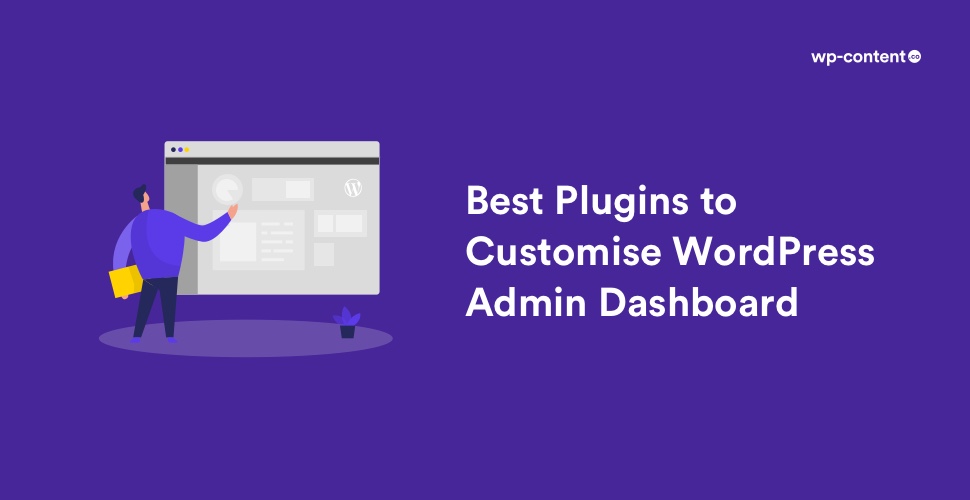As a WordPress site owner, the WordPress admin dashboard is the most important part of your website. It is the area that keeps all information, plugins, and tools so that the administrator can manage the site easily. Also, you can create new pages, change themes, and set up your entire site with a few clicks. The WordPress dashboard has changed exceptionally over the past years, and there’s no question it has come a long way. But still, you might have often felt that the default WordPress dashboard is quite unexciting with only a few widgets that aren’t very useful.
The default dashboard still doesn’t cater to a wide variety of use cases such as adding extraneous dashboard widgets and menu items, or implementing an off-brand User Interface, etc. For such purposes, one will have to turn to plugins. There are several plugins that help to customize WordPress admin dashboard. They not only improve your front-end functionality but also enhance the dashboard for better usability and control.
In this post, we’ll list the best admin dashboard plugins you can use to customize the look and functionality of your website’s admin area.
- 1. Dashboard Widget Suite
- 2. White Label CMS
- 3. Ultimate Dashboard
- 4. Admin Menu Editor
- 5. Statify
- 6. Disable Admin Notices individually
- 7. Wider Admin Menu
- 8. Admin Columns
- 9. WP Custom Admin Interface
- 10. Dashboard Notes
- 11. Controlled Admin Access
- 12. White Label
- 13. Admin Management Xtended
- 14. Slash admin
- 15. Post types Order
- 16. Dashboard Cleaner
- 17. Admin Notices Manager
- 18. Dashboard Columns
- 19. Admin Menu Search
- 20. Hide Admin Bar Based on User Roles
- 21. Dashboard Feed Widget
- 22. Show modified Date in admin lists
- 23. Admin Menu Post List
- 24. Custom Admin Page
- 25. Dashboard quick links widget
- 26. WP Admin/Dashboard Search Spotlight
- 27. Better Notifications for WP
1. Dashboard Widget Suite
Dashboard widget suite is a perfect choice if you want to go with tons of new dashboard widgets. It’s free and works for all versions of WordPress with relevant updates too. The plugin shows a ton of related information about your website, database info, Server info, custom notes, social buttons and a debug log for your server. Also, you have full control over all of these widgets. You can decide which ones you want to be visible and where you want them to be placed on the screen. In total, the Dashboard Widget suite is the best plugin for WordPress users who aren’t much into the technical side but still want access to the dashboard when required.
Also read: How to Customize WordPress Dashboard Easily
2. White Label CMS
If you’re using WordPress to create a client’s website, you can use this plugin to customize the admin area according to your client’s needs and requests. Apart from giving you the space to create a branded login page, it provides you three preset CMS profiles: Website, Blog, or Custom to modify the menu system. You can also write a custom message to your clients with instructions on how to use and navigate the admin section. If you are interested in adding your developer branding into the admin area, White Label CMS gives you the option to add your logo in the admin header and footer section.
3. Ultimate Dashboard
With the Ultimate Dashboard plugin, you can simplify how your WordPress looks. If your default Admin dashboard is cluttered, this plugin can help you declutter it by replacing or removing widgets. The plugin also allows you to use quick links to replace default widgets for faster access, support third-party widgets, customize admin and login screen as a way of branding your website and an option of creating Vimeo and YouTube video widgets that open in a lightbox within the dashboard.
4. Admin Menu Editor
The Admin Menu Editor is an excellent plugin that every web admin should have. It allows administrators to personalize the WordPress default menu to one’s choice. You can create a new custom menu or reorder the default one to your liking. This plugin is fantastic in that it gives the dashboard better usability. This plugin features a drag-and-drop interface to rearrange your menu items in the admin area. You can also customize the login page and remove WordPress’s branding from the top bar.
5. Statify
Statify WordPress dashboard plugins is a privacy-friendly plugin which neither uses cookies nor any third party. This plugin provides straightforward and compact access to the number of times a site is viewed. It comes with an interactive chart which is followed by the lists of the most common sources and target pages. You can directly set the length of lists and the period of statistics in the dashboard widget.
6. Disable Admin Notices individually
With this plugin, you can turn off notices forever individually for themes, plugins and WordPress itself. It adds a “Hide notification forever” link for each admin notice. Select this link and the plugin will filter this notice and you will never see it. At the same time, this method will help you to disable only annoying notices from plugins and themes, but important error notifications will continue to appear. You can also disable all notifications globally by simply changing the plugin options. In this case, the plugin hides all admin notices, except for updates notices in the list of installed plug-ins.
Also read: Helpful Tools to Manage Multiple WordPress Sites From One Dashboard
7. Wider Admin Menu
Wide Admin Menu is a lightweight and amazing plugin that lets you set the width of the admin menu. In addition to this, it is an open-source WordPress plugin. Moreover, if you need to avoid another plugin then the particular style sheet is available for you. Furthermore, this plugin will have no trace. It simply means, if you delete this plugin, then all settings will be removed from the database automatically. In contrast, just deactivating it will leave your settings like it is, as we scheduled.
8. Admin Columns
Admin Columns enables you to modify the organization of post (and custom post type) list pages. It offers full flexibility to rearrange or edit columns, as well as choose from more than 70 custom field types that can be used to create new columns. The plugin can transform the WordPress admin screens into beautiful, clear overviews. Most of the time, what WordPress offers by default is irrelevant. However, using Admin Columns curates the experience.
9. WP Custom Admin Interface
With WP Custom Admin Interface you can easily customize the WordPress admin menu, toolbar, the admin and login interfaces. WP Custom Admin Interface provides a whole range of stunning admin features which other plugins will charge you for. It provides a simple interface to customize the backend of WordPress to provide a more customized experience for you and your clients or customers. WordPress administrators who manage multiple websites will appreciate the simple plugin settings export feature which will enable you to deploy customizations to multiple sites you manage.
10. Dashboard Notes
As the name suggests, Dashboard notes help you to save your notes/ideas in the Admin dashboard. For any web developer or content creator, note-taking is quite essential as ideas are more likely to be forgotten if they are not written down. Even though WordPress allows you to put down your thoughts in the form of a draft, you cannot keep it for long. With this plugin, you can create a note easily and keep it on the dashboard for quick access in the future. To create a new note, click on “Appearance” then “Widgets” and add your note.
11. Controlled Admin Access
The plugin is simple and user friendly. It helps the administrator to create a user with temporary access and choose which pages in your admin area which you don’t want the user to access. You can send the details to the user and when he finishes his task, you can easily deactivate the account and activate it later.
Also read: Best Elementor Addons
12. White Label
White Label allows you to customize the WordPress login, admin area, remove menus and much more. You can add a custom logo, custom login and create a complete custom WordPress dashboard with your own widget and other features to help clients use WordPress. You can also add your own informative dashboard widget to improve client support with easily accessible tutorials, FAQs, and instructions right there in the dashboard. You can also add images and videos.
13. Admin Management Xtended
Admin Management Xtended adds some icons to the posts/pages management panel with AJAX-driven CMS-known functions like toggling post/page visibility, changing publication date and title without having to open the edit screens or reload the page. It also enables you to change the page order with drag and drop, inline category management and inline tag management, etc.
14. Post types Order
It allows you to reorder the posts for any custom post types you defined, including the default Posts. Also, you can display the posts within the admin interface sorted per your new sort. Most WordPress users require to change the order of the posts. There are two ways to do this. One can do that manually, by changing the WordPress Order field with a unique number for each of the posts, which surely can turn into a difficult task if there are lots of posts. Another way is to use the Post Types Order plugin, which represents a fast and easy way to update the sorting through a JavaScript drag and drop interface.
15. Dashboard Cleaner
Keeping your client sites’ wp-admin clean from extra admin menu items and dashboard widgets can be a pain to have to clean up. Dashboard Cleaner allows you to hide any HTML elements from your admin dashboard such as annoying banners, unwanted ads and other nuisances, etc.
Also read: Best Help Desk and Support Ticket Plugins for WordPress
16. Admin Notices Manager
Very often users are disturbed by the number of admin notices that pop up on their WordPress dashboard. Sometimes there are so many that the WordPress dashboard is below the scroll. The Admin Notices Manager plugin solves this problem by moving the admin notices out of the main dashboard view to a central place so that you are not disrupted. This allows you to keep on working and read the notices at your convenience at a later time, without missing any important WordPress core, plugins and themes messages.
17. Dashboard Columns
With the help of Dashboard Columns, you can easily change the number of columns in your admin dashboard. By selecting your preferred layout from the Screen Options menu you can better customize the look and feel of your widgets too without compromising the responsive UI. On large screens, you have the option to choose between four columns. On medium screens, you have the option to choose between 1 or 2 columns and on small screens, everything is displayed using 1 column.
18. WP Adminify
With WP Adminify customizing the WordPress dashboard be it yours or clients is a simple task. The features offered by the plugin are vast and it bestows you with everything you ever need to make a truly unique dashboard. The plugin offers an admin columns customizer, media/post type folder for simplifying content management, the feature to edit the menu items easily and effortlessly, WPML support, multisite support, and many more features.
19. Admin Menu Search
Admin Menu Search is a simple plugin that adds a search box to the top of the Admin Menu in the WordPress Dashboard. No more scrolling up and down or using your browser’s Ctrl+F or Find function to locate menu items. Just enter a few characters in the Search Menus field and the Admin Menu will be trimmed down to only the items that match your search. Submenus are also included in the search, so if you’re looking for “Widgets” it will keep the “Appearance” menu in the list because Widgets live under Appearance / Widgets.
20. Hide Admin Bar Based on User Roles
As the name suggests, Hide admin bar is a very useful plugin to hide the admin bar based on selected user roles and user capabilities. It helps you to hide the admin bar from the frontend for all user types including guest users. You can also choose user roles to hide the admin bar for that specific user role.
Also read: Best Affiliate WordPress Plugins
21. Show modified Date in admin lists
Show modified Date in admin lists shows a new, sortable, column with the modified date in the lists of pages and posts in the WordPress admin panel. It also shows the username that did the last update. The idea of the plugin is based on the plugin Sort by modified which has some problems displaying the information correctly in the latest WordPress versions.
22. Custom Admin Page
This is a simple plugin that adds unlimited WordPress custom pages to your admin dashboard. You get to add as many pages as you want, customize the appearance using TinyMCE, Gutenberg, WPBakery Page Builder, and Divi Builder. The default settings of the plugin include setting custom page order, adding custom page to parent page, choosing custom page icon for the sidebar menu etc.
23. Dashboard quick links widget
Dashboard quick links widget is a lightweight plugin that allows users to create a Dashboard widget with frequently accessed wp-admin menu for quick access. The plugin was developed after spending hours of time creating client/user documentation for every WordPress project.
Also read: Best Appointment Booking WordPress Plugins
24. WP Admin/Dashboard Search Spotlight
WP Admin/Dashboard Search Spotlight is a powerful global quick navigation search plugin for WordPress Dashboard – it is an advancement of the default WordPress dashboard search. You can set it up to search anything on your WordPress Dashboard like pages, posts, comments, orders, users and many more options. You will see the search results at lightning speed and as you type, search results will become more accurate. Moreover, you do not need to explore your WordPress dashboard to find any menu. Just type a word and you will be presented with all available options/menus on your site.
25. Better Notifications for WP
Better Notifications for WP is a powerful plugin that allows you to customise the email notifications that WordPress sends using the WYSIWYG editor and shortcodes. All of the default WordPress email notifications are available to customise as well as lots of new ones. You can choose to send notifications to individual users, multiple users, all users in a user role or multiple roles. You can also power up your notifications with Premium Add-ons. Emails are sent out through your WordPress website (using wp_mail) but can be sent via SMTP using an appropriate 3rd party plugin if you wish.
Final Thoughts
Even though WordPress offers plenty of customization options on the front-end, the back-end area can be lacking out-of-the-box. Fortunately, you can expand WordPress’s functionality with an admin dashboard plugin, making your or your client’s site management tasks easier and more efficient. If you made it all the way here, we would love to thank you for your time to read our article. We hope you’ve found what you were looking for and got some good ideas for your WordPress dashboard. If you have any suggestions or feedback for our WP admin article, please comment in the section below. We would love to hear it!
Disclosure: This post may contain affiliate links, which means we may receive a commission if you click a link and purchase something that we shared. Read more about Affiliate disclosure here.



























